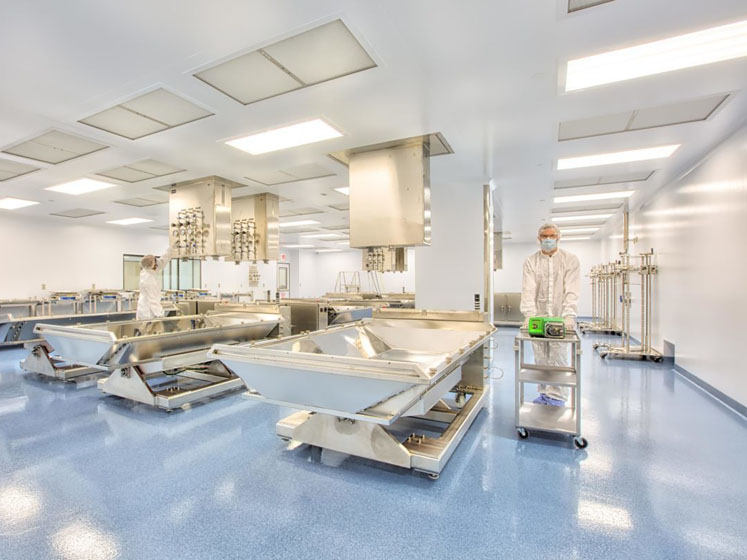Cleanroom engineering and fabrication have matured to meet the evolving and growing demand for more flexible, cost-efficient aseptic manufacturing space. Cleanroom space and the sterile processing capacity within it is a mandatory prerequisite to produce the sterile injectable vaccines and biologic therapeutics that are now in high demand by healthcare providers (HCPs) and patients.
More sterile aseptic manufacturing capacity needed … stat
Because biologics have been so effective and offer better therapeutic value for less cost, demand for these kinds of drugs will continue to rise — along with a call for a relatively sharp increase in manufacturing capacity to serve more patients globally.
In 2020, according to market research company NextMSC, the global biopharmaceuticals market was valued at $291 billion. Dramatic growth is expected note analysts who project that the market will increase to nearly $1 trillion by 2030.1 Fuelling overall growth in the sector, Visiongain expects the global advanced therapy medicinal products ATMP market to reach $59.91 billion by 2030.2
Biopharma’s response to this demand is drawing an astonishing amount of capital to the sector and, with it, a call from the industry for millions of square feet of new, efficient cleanroom manufacturing space. BioPlan Associates’ Technical Research Director, Ronald A. Rader, recently noted that the industry’s bioprocessing sector is extremely dynamic and will continue to expand in revenue, importance, and diversity.
With worldwide sales of biopharmaceuticals approaching $400 billion per year — according to Mordor Intelligence — and increasing at approximately7% annually, Rader believes that the need for bioprocessing infrastructure, supplies and services will also keep pace, noting that new capital investments in bioprocessing equipment are growing at 8.7% on average.3,4

BioPlan Associates’ survey revealed that an increasing number of current good manufacturing practice (cGMP)facilities are being planned, which includes the modular-constructed facilities and cleanrooms necessary to meet the expanding global demand for pharmaceuticals in every category (especially biologics).4
Cost-efficient cleanroom solutions delivered as a system
All commercial injectable drugs have two things in common: one is that they must be 100% sterile; two, they require the highest levels of operational excellence to manufacture and distribute them successfully. Industry analysts confirm that many pharmaceutical and biotech firms outsource a significant portion of their sterile fill-and-finish to expert external partners.
Again, following the growth of the biopharmaceutical sector, the global fill-finish pharmaceutical contract manufacturing market size is likely to reach $14.0 billion by 2030.5
Cleanroom costs unsustainable history
Cleanrooms used to be engineered and constructed on-site during long complex project timelines using stick-built construction methods. For much of pharma’s facility engineering history, the fact that this method was tough to deliver on schedule, manage efficiently and both complex and expensive to construct was never really a problem — just as long as it functioned and sterility and environmental health and safety was compliant.
With parenteral biologic drugs, every dose requires an aseptic process train within a highly controlled manufacturing space to ensure 100% product sterility. For much of pharma’s manufacturing history, sterile environments were dedicated to a product and built large enough to achieve the economies of scale necessary to deliver a return on the capital invested.
Cleanrooms by committee
Often, to deliver a defined, engineered commercial biopharma cleanroom space to facility owners, the project would traditionally assemble a list of related contractors and technology integrators. Depending on the project manager’s preferred approach and experience, such a list might include a myriad different contractors possessing a wide range of experience and qualifications for a project. This may include
- walls and ceilings
- flooring
- glass details
- doors and controls
- lighting fixtures
- heating, ventilation and air conditioning (HVAC) systems
- process and building utilities
- HVAC building management
- environmental monitoring systems
- fire and life safety systems.
This incomplete list highlights the exponential complexity in terms of experience, resources and risk when co-ordinating a fast-track multimillion-dollar project with contractors, costs and end users all requiring consideration. The probability of success is challenged at every turn, especially when it comes to achieving project goals of budget, schedule and quality.
A systems approach that preintegrates enabling technologies
One thing the industry has learned with time is that the complexities of these on-site integrations were often mitigated by modular approaches to the subsystems and elements of the cleanroom delivery strategy. This engineering philosophy has only gained popularity because of its inherent efficiencies.
Most plant operators understand that one key benefit of having a single-source system supplier comes well after construction and commissioning.
A common complaint that new plant operators often have is that once commissioning is complete and the construction team leaves the project, there is no one company available to resolve technical issues with any of the critical cleanroom subsystems.
These drivers have led to significant innovation by modular cleanroom technology providers, primarily in the form of integrating a systems approach to cleanroom fabrication. Pharma’s facility engineers understand that the best way to cost-effectively implement cleanrooms is to leverage the advanced modular design, engineering and prefabricated components and have it delivered as an engineered system from the beginning.
Currently, a broad array of key enabling technologies leveraging modular concepts and factory fabrication are available from modular cleanroom systems manufacturers. Above all, these technologies offer the flexibility and configurability pharma needs to meet specific facility and product cleanroom requirements:
- modular engineered architecture, featuring antimicrobial materials and finishes applied in a controlled factory setting
- walkable ceilings, allowing operational access to critical systems that serve the cleanroom without interrupting operations within it
- glass wall/curtaining prefabricated, designed to maximise visibility within the cleanroom environment
- integral HVAC systems that control temperature, humidity, cleanliness, pressure cascade and containment
- integrated linear LED lighting and controls for energy efficiency
- prepopulated modular electrical raceways and standardised utility connections that simplify installation
- integrated control and monitoring technologies for plug and play integration.
Developed with standard modular factory manufactured components, cleanroom systems are purposely designed to simplify the implementation and integration of the aseptic manufacturing space that pharma needs to meet future sterile injectable capacity demand.
Modularity’s value proposition is built in from the start
Modular cleanrooms accelerate project schedules and lend themselves to fundamental and superior capital investment benefits that traditional methods can’t accommodate. The industry’s modular cleanroom integrators understand critical co-ordination — from process systems to infrastructure tie-ins — is required to ensure there are no gaps in responsibility that can disrupt project timelines or operations later.
This includes a “showroom” sterile interior fit and finish that has become the gold standard for CDMOs competing for very demanding biopharma clients.
The modular cleanroom systems available today are engineered to accommodate virtually any commercially viable floorplan (both horizontally and vertically). This approach is more flexible and cost-effective and offers higher quality at a competitive price. The concept also offers expedited validation timelines compared with traditional stick-built facilities through the early availability of commissioning documentation packages.

Modular configurable cleanroom systems can relieve project managers from the many “unpredictabilities” of project execution by directly sharing the risk with an experienced provider. When executed properly, it’s a well proven fact that modular technology can shave months off construction timetables because it streamlines installation and minimises co-ordination with all other trades and contractors on site.
Although there are many factors to consider, the capital cost of a modular cleanroom project is often comparable with traditional solutions. But if you consider the value proposition of maintainability and flexibility during a facility’s lifecycle, the project benefits become clear.
All evidence suggests that modular innovation is winning in the market. According to Fact.MR analysts, the global modular cleanroom solutions market is set to experience rapid growth at a compound annual growth rate of more than 10% from 2020 to 2030. Further, they report advancements in cleanroom construction and the adoption of integrated IoT-based HVAC systems are also expanding the demand for modular cleanroom systems.6
It is clear that during the past 15 years or more, modular cleanroom facilities have become a key enabler in the safe and effective manufacture of biologic drug products; and, with each breakthrough proving how effective the solution is, this helps pharma to build out capacity in a financially sustainable way.
Modular cleanroom solutions also deliver key development and commercialisation goals by providing accelerated project timelines and predictable results that ensure regulatory agency approval milestones.
References
- www.statista.com/statistics/1293077/global-biopharmaceuticals-market-size/.
- www.globenewswire.com/news-release/2021/06/02/2240474/0/en/The-Global-Advanced-Therapy-Medicinal-Products-Market-is-projected-to-reach-at-market-value-of-US-59-91-billion-by-2031.html.
- www.mordorintelligence.com/industry-reports/global-biopharmaceuticals-market-industry#:~:text=Market%20Overview,impact%20on%20the%20biopharmaceutical%20industry.
- https://bioprocessintl.com/business/economics/top-trends-in-biopharmaceutical-manufacturing-2020/.
- www.bloomberg.com/press-releases/2022-07-05/fill-finish-pharmaceutical-contract-manufacturing-market-worth-14-0-billion-by-2030-grand-view-research-inc.
- www.factmr.com/media-release/1823/global-modular-cleanroom-solutions-market.




